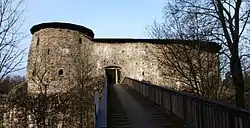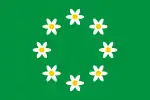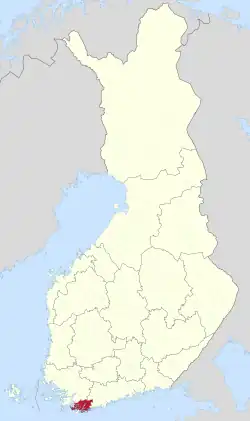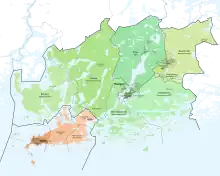Raseborg
Raseborg (Finland Swedish: [ˈrɑːseˌborj]; Finnish: Raasepori, Finnish: [ˈrɑːseˌpori]) is a town (administrative area) and municipality of Finland. It was created on January 1, 2009, when the municipalities of Ekenäs, Karis and Pohja were consolidated into a single town,[5] creating the largest Swedish-speaking-majority city of Finland in terms of population. Of these, Ekenäs now serves as the administrative center of Raseborg. The name of the new town is based on the Raseborg Castle located in Ekenäs, or formerly in the municipality of Snappertuna. Historically the name of the county was also Raseborg in the 14th century.
Raseborg
Raseborg – Raasepori | |
|---|---|
Town | |
| Raseborgs stad Raaseporin kaupunki | |
 | |
 Flag  Coat of arms | |
 Location of Raseborg in Finland | |
| Coordinates: 59°58.5′N 023°26′E | |
| Country | |
| Region | Uusimaa |
| Sub-region | Raseborg sub-region |
| Charter | 2009 |
| Administrative centre | Ekenäs |
| Government | |
| • Town manager | Petra Theman |
| Area (2018-01-01)[1] | |
| • Total | 2,354.24 km2 (908.98 sq mi) |
| • Land | 1,147.70 km2 (443.13 sq mi) |
| • Water | 1,206.47 km2 (465.82 sq mi) |
| • Rank | 67th largest in Finland |
| Population (2023-09-19)[2] | |
| • Total | 27,316 |
| • Rank | 39th largest in Finland |
| • Density | 23.8/km2 (62/sq mi) |
| Population by native language | |
| • Swedish | 64% (official) |
| • Finnish | 30.7% |
| • Others | 5.4% |
| Population by age | |
| • 0 to 14 | 14.5% |
| • 15 to 64 | 58% |
| • 65 or older | 27.6% |
| Time zone | UTC+02:00 (EET) |
| • Summer (DST) | UTC+03:00 (EEST) |
| Climate | Dfb |
| Website | www.raseborg.fi |
The town has a population of 27,316 (19 September 2023)[2] and covers an area of 2,354.24 square kilometres (908.98 sq mi) of which 1,206.47 km2 (465.82 sq mi) is water.[1] The population density is 23.8 inhabitants per square kilometre (62/sq mi). The town is bilingual, the majority of the town being Swedish-speakers, taking up two-thirds of the population (66.2%) and Finnish-speakers being the minority, which approximately takes up the remaining one-third of the population (31%).
The coat of arms of Raseborg, introduced in 2009, is inspired by the area's grove biotope and the eight former municipalities that originally belonged to the united municipality, which are symbolized by white windflowers arranged in a circle. The yellow wall crown on top of the green shield in the area therefore belongs to the history of the region and its the three fortresses (inclunding the Raseborg Castle).[6] In addition to the coat of arms, the town of Raseborg uses a flag and pennon based on the coat of arms.[7] The coat of arms has attracted criticism for its "non-heraldic structure".[8]
In February 2011, Raseborg Municipality entered into a "Friendship Co-operation Agreement" with Makana Municipality in South Africa. The project, which is to last three years, seeks to facilitate information sharing in the fields of economic development, arts and culture, women's development, youth development, and education.[9]
History

Raseborg as a municipal name is a new coinage, but the castle of Raseborg was first mentioned in 1378 as Rasaborge. It acted as the center of the Raseborg slottslän (Finnish: linnalääni) covering western Uusimaa and some parts of Finland Proper such as Kisko.
The area of the modern municipality had eight municipalities at its peak: Ekenäs, Ekenäs landskommun, Snappertuna, Karis, Karis landskommun, Pohja, Tenala and Bromarv. The first merger in the area happened in 1969, when Karis landskommun was merged into Karis. By 2008, only Ekenäs, Pohja and Karis were independent municipalities, forming the modern Raseborg municipality in 2009.[10]
Politics
After the 2021 municipal election the municipal council of Raseborg became the following:[11]
| Party | Share of vote (%) | Seats |
|---|---|---|
| Swedish People's Party | 49.2 | 23 |
| Social Democrats | 27.6 | 12 |
| Greens | 7.5 | 3 |
| National Coalition Party | 5.9 | 2 |
| Left | 4.6 | 2 |
| Finns Party | 4 | 1 |
See also
References
- "Area of Finnish Municipalities 1.1.2018" (PDF). National Land Survey of Finland. Retrieved 30 January 2018.
- "Finland's preliminary population figure was 5,587,841 at the end of August 2023". StatFin. Statistics Finland. Retrieved 30 September 2023.
- "Demographic Structure by area as of 31 December 2022". Statistics Finland's PX-Web databases. Statistics Finland. Retrieved 6 September 2023.
- "Population according to age (1-year) and sex by area and the regional division of each statistical reference year, 2003–2020". StatFin. Statistics Finland. Retrieved 2 May 2021.
- "Local Councils Vote to in Favour of Municipal Merger". Yle.fi. YLE. 2007-06-19. Retrieved 2007-06-19.
- Strömberg, Henrik (14 May 2008). "Raaseporin kaupungin uusi vaakuna" (PDF) (in Finnish). Archived from the original (PDF) on 2015-09-25. Retrieved 17 March 2023.
- "Vitsipporna blommar på Raseborgs vimplar". svenska.yle.fi (in Swedish). Yle. Retrieved 17 March 2023.
- "Heraldiikan säännöt ja tyyli koetuksella Raaseporin vaakunassa". Etelän Uutiset (in Finnish). 21 May 2008. Retrieved 17 March 2023.
- "Finland Trip Feedback". Makana Municipality. Archived from the original on 2012-04-19. Retrieved 2011-11-29.
- "SuomalainenPaikannimikirja_e-kirja_kuvallinen.pdf" (PDF). kaino.kotus.fi (in Finnish). p. 367. Retrieved December 21, 2022.
- "Yle - Result service - Raasepori - Uudenmaan vaalipiiri - Municipal Elections 2021 - Yle.fi". vaalit.yle.fi. Retrieved 2021-09-07.
External links
 Media related to Raseborg at Wikimedia Commons
Media related to Raseborg at Wikimedia Commons Raseborg travel guide from Wikivoyage
Raseborg travel guide from Wikivoyage- City of Raseborg – Official website (in Swedish and Finnish)
- Makana-Raseborg - blog documenting the progress of the friendship co-operation agreement
